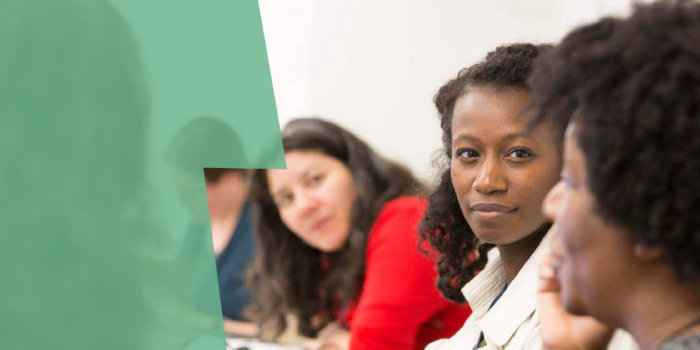How can your staff co-create your brand?
Ambar Mentor-Truppa, VP of Communications at the Shriver Center on Poverty Law, chats with Big Duck’s Gil Mejia and Sarita Joseph about the rebranding process. Formerly a communications consultant to nonprofits, Ambar shares her collaborative approach, ensuring all key stakeholders have a say in the decisions that affect them.
Transcript
Sarita Joseph: Hi, my name is Sarita Joseph. I’m a Senior Account Manager at Big Duck and I’m joined by my lovely colleague, Gil…
Gil Mejia: Hi, Sarita.
Sarita Joseph: … And Ambar Mentor-Truppa from the Shriver Center on Poverty Law.
Ambar, thanks so much for joining us all the way from Chicago.
Ambar Mentor-Truppa: Yeah, I’m so thrilled to be here so thank you for having me.
Sarita Joseph: Do you mind telling us a little bit about yourself and telling us about the Shriver Center’s great work?
Ambar Mentor-Truppa: The Shriver Center on Poverty Law is a legal advocacy organization and we work for economic and racial justice. We do state policy and litigation on a range of issues from housing to healthcare, criminal justice reform, and public benefits, and then we also train, equip, and mobilize a national network of legal advocates as well. We do that all with a racial justice lens.
Sarita Joseph: Excellent. We’ve asked you to join us today on our podcast because we’ve watched you navigate a name evolution and a full rebrand process with such a great eye for engaging your staff and your board along the way.
Gil Mejia: And that’s exactly what we’ll be discussing here today, why it’s important to make your staff and board a primary audience to your brand.
So Ambar, why don’t we begin by talking a little bit about the motivations that led to the rebrand. What is it that the Shriver Center was striving to achieve with the rebrand and why are your staff and board crucial to that goal?
Ambar Mentor-Truppa: We’ve been doing this critical state and local advocacy work for more than 50 years now and we really needed a strong foundation for this next era of the fight for justice and we really wanted a strong brand that set us up as an influential leader in our field, but we realized it was also really important for our staff and our board to be aligned around this new voice—what we’re amplifying, what we’re trying to do. Our strategic plan called for a more unified organizational culture and the rebrand was actually a really key component in reaching that goal. So we have lot of internal and external goals related to the rebrand.
Gil Mejia: That conflict of voice as it relates to the brand, that totally resonates with us as we see that it’s important for staff and board to sort of, be behind the voice they could find themselves in and a voice they could be conduits for. So that’s really exciting.
Sarita Joseph: Ambar, have you ever been a part of a process that required a lot of planning and important decision-making where all the necessary voices were not included in the planning stage? Do you mind sharing a story if you have one?
Ambar Mentor-Truppa: Yeah, well, I really think it’s my collective experience actually being where you guys are. So, I spent most of my career as a communication consultant to nonprofits and really trying to also advance things like branding new initiatives and communication strategies for big advocacy campaigns and they involved a lot of stakeholders. So I learned really early on that organizations that have missions have a lot of people invested in them. That’s staff, that’s board, donors, and funders, other partners. So I learned early on to do a lot of that alignment and then I also worked on a lot of civic and city initiatives that had community members, government officials, civic leaders, business community. I’ve just learned early on that a lot of voices have to be at the table, so that’s just been a core part of my ethos, I guess, as a communications professional.
Gil Mejia: Can we talk a little bit about the Shriver Center more specifically and sort of the opportunities that you saw for the organization? What was it that was important for Shriver to have a consensus or interprocess?
Ambar Mentor-Truppa: Well one thing to keep in mind is that the Shriver Center’s strategic communications capacity is also fairly new, so I joined the organization three years ago as the first ever senior leader in communications and really going from a decentralized way of doing this work to a more centralized, strategic way. So I think the rebrand—It’s also been a really great opportunity to ground everybody on the principles of communications, understanding what strategy means, what goals and audience are doing in service to larger organizational goal. So that’s been really key, and I think other things that have really driven the participatory process for Shriver has just been our own central values around ensuring that people have a voice in the decisions that affect them.
That’s what guides our advocacy work and actually our founder Sargent Shriver, who led the war on poverty and started the Peace Corps and many other programs and legal services for the poor, he was all about going into communities, asking people about what impacted their lives, what were the changes that they wanted to see. So I think it’s in our DNA and so, I knew when this project was going to launch that it had to be all of us, it wasn’t just going to be my project. It wasn’t just going to be the project of the communications team. It really needed to be owned by the whole organization.
Sarita Joseph: Yeah, how cool that it’s very authentic to your mission and how you work as a team.
Ambar Mentor-Truppa: Yeah, we’re living our values.
Sarita Joseph: Yeah, that’s great to see.
So Ambar, paint a picture for us. How did this process come to life at the Shriver Center? What tools did you use to amplify the voices of your brand and staff. And me, as an Account Manager here at Big Duck, these are the strategies I try to use with clients and we have a lot of brainstorming sessions on how to reach the board and staff. So I’m very curious about this question.
Ambar Mentor-Truppa: Yeah, it’s been a lot of engagement. It’s really been a lot of conversations in different settings and in different spaces. On a tactical level, that’s a lot of email communications, and meetings, and weekly recaps with our president, with my communications team, staff briefings when appropriate. So, there’s just a lot of conversations happening. I also wanted to ground people in what the core principles are around the work that we’re doing and that’s actually been just a great partnership with you all at Big Duck because you’ve given me great resources, your blog has been fantastic, your Brandraising model is really a clear visual to take people through the steps of all the elements that make up a brand. So, I also wanted to use this process for education. So I think we’ve all learned a tremendous amount of what we’re doing, and so it makes it better to contribute when we really understand all the fundamentals of that process.
So a lot of engagement, a lot of calls, a lot of video conversations with people, and this hasn’t just been staff and board. I’ve talked to donors, I’ve talked to our community partners, we’ve brought in other advocacy partners to weigh-in at various junctures of the rebranding process.
Sarita Joseph: Yeah, it’s been nice to see it all unfold from our end.
Ambar Mentor-Truppa: I guess one thing too that I’ll add is that we’ve also just tried to develop strategic teams and working groups so we have a core working group, but we also have a different team that’s leading messaging, that’s talking through brand architecture, through our multiple external programs. We have a team that’s thinking through the roll-out, the website, what materials are going to look like, so we’ve been trying to tap people from all parts of the organization at the appropriate junctures to contribute to all of it.
Sarita Joseph: And, even with your staff and board, there are different spheres of responsibilities and involvement and even interest in branding efforts, and how do you customize your approach for different stakeholders? I know you talked a little bit about that but I’d love to hear a little bit more about it.
Ambar Mentor-Truppa: You know, I think those who really want a close seat, I bring them as close as I can at the moment. Have a conversation with me about some ideas, send me some links, I take all of that in, or if it’s a sneak-peek I could give someone who really wants to be in, I’ll try to do that. You know and for folks that maybe don’t care about the day-to-day as much, it’s still important to keep it high level. Then I’ll send the staff the regular email updates or we’ll still try to do a brief piece at the staff meeting and make sure folks have time for questions.
Gil Mejia: So let’s say some months have passed and the new brand has successfully launched, they have been developed, everyone is enjoying its wonders, the strategy is coming to life, what does launch look like for staff and board? How are you prioritizing staff and board at this stage in the process where you’re sort of ramping up to get everyone to use this brand as their own?
Ambar Mentor-Truppa: So my crystal ball, I hope, would predict that we have a brand that we are unified around that feels really authentic to us and that we’re excited to share with the world. I think leading up to it, we’re going to have a lot more conversations and hopefully these are going to be more active where we’re not just internalizing what we’ve put together but really trying to think through how are we going to live that out, how are we talking in a more unified way, how are we looking at our visuals and our materials, and just delivering a really strong story. So, I’m excited that we’ll be able to collaborate and we’re already at the beginning stages of that. And I think training, but I think it’s really going to be more of just immersing ourselves and just trying on this new, refreshed presence and feeling good about owning it. So I’m hopeful that we’re going to have a lot more conversations and active sessions where we start to embrace this new brand.
Gil Mejia: How do you manage having so many different opinions, voices, and feedback, and how do you use that to make decisions and keep the process moving along productively?
Ambar Mentor-Truppa: I would say don’t be afraid to engage other people. I think part of the journey, especially in a branding process, is listening to all of the different perspectives that shape that organizational voice and a recognition that some ideas may not come to fruition, but it doesn’t mean that the thought behind them don’t inform or shape decisions later down the road. I think it’s also just really important for everyone to constantly remember strategy—what are our goals, what are we trying to achieve, what is that central North Star for us, and just having those check-ins starting your sessions and your decision-making processes with that strategy in mind is always a really helpful starting place because that’s what we all agreed on. That’s what we’re in service to, so let’s work collaboratively together.
Gil Mejia: Thank you so much for being here.
Sarita Joseph: I can’t wait to see it all come to fruition.
Ambar Mentor-Truppa: And I just want to shout out the Shriver Center staff, I mean, they are an amazing group of advocates really passionate about achieving economic and racial justice in this country, and it’s just really been a pleasure to work for them and for this organization so I’m so excited for us all to embrace this new brand. It’s been a really great journey and I think now, now we’re ready for the brand to be for everyone else.
Sarita Joseph: Yeah, excellent.
Well thank you so much for joining us today, Ambar. It’s been a pleasure.
Ambar Mentor-Truppa: This has been wonderful, thank you.
Sarita Joseph: Thank you.






